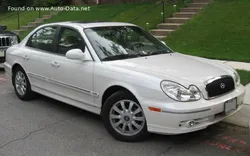

Hyundai Sonata - Generation 4 EF Facelift 2001
Explore the Hyundai Sonata Generation 4 EF Facelift 2001, its features, specs, and market performance. Discover how this model stands out in Portugal.
The Hyundai Sonata has become one of the most recognizable names in the automotive industry, representing durability, value, and innovation. The fourth generation, known as the EF series, marked ...
Technical Specifications
Select Version
Dimensions
Engine
Driving
Others
History and Features
Mycarro AI
Apr 26, 2025
The Hyundai Sonata has become one of the most recognizable names in the automotive industry, representing durability, value, and innovation. The fourth generation, known as the EF series, marked a significant turning point for Hyundai. Released initially in 1998 and followed by a facelift in 2001, the EF Sonata exemplifies a harmonious blend of design, performance, and functionality. This article explores the characteristics, developments, and influence of the facelifted version of the fourth-generation Sonata.
Design and Aesthetics
The 2001 facelift of the Hyundai Sonata EF introduced a more refined and stylish exterior compared to its initial debut. The vehicle maintained its four-door sedan design but embraced smoother lines and a more aerodynamic silhouette. The updated front fascia featured a new grille design and sleeker headlights that contributed to a more modern look. The overall design language was a departure from Hyundai's earlier, boxy models, embodying a more sophisticated appeal that could compete in the mid-size sedan segment.
Interior Comfort and Features
Inside the Hyundai Sonata EF, the facelift brought significant advancements, particularly in terms of comfort and technology. The cabin was designed with a focus on passenger comfort, featuring improved materials and a more user-friendly layout. The dashboard was revamped to include updated instrumentation and controls, providing a more ergonomic experience for drivers and passengers alike. Notable features included power windows, air conditioning, and a premium audio system, all of which enhanced the overall driving experience.
Engine and Performance
Under the hood, the Hyundai Sonata EF (facelift 2001) offered a range of engine options that catered to different driver preferences and performance needs. The lineup typically included a 2.0-liter DOHC engine and a more powerful 2.4-liter option, both of which were designed to deliver a satisfactory balance of power and fuel efficiency. The 2.4-liter variant stood out for its better acceleration and responsiveness, appealing to those seeking a sportier drive. Furthermore, Hyundai incorporated five-speed manual and four-speed automatic transmission options to suit various driving styles.
Safety Features
As safety became a priority in the automotive industry, the 2001 facelift brought important enhancements in this area as well. The Hyundai Sonata EF included features such as dual front airbags and anti-lock braking systems (ABS), which were becoming standard expectations for new vehicles. The car's structural integrity and design had been improved to ensure better crash performance, contributing to several positive safety ratings during its time.
Market Reception and Impact
The facelifted Hyundai Sonata EF was well-received in the market and played a crucial role in establishing Hyundai's reputation as a competitive automaker on the global stage. With its curated blend of affordability, style, and features, the Sonata appealed to a broad demographic, ranging from families to young professionals. The success of the EF series also signified a shift in consumer perception; Hyundai began to be viewed not merely as a budget brand but as a manufacturer capable of delivering quality and innovation.
Legacy
The fourth-generation Sonata, particularly the 2001 facelift, served as a foundation for future Hyundai models, pushing the company to continuously innovate. Its success paved the way for the development of more advanced generations of the Sonata that followed. Over time, Hyundai solidified its place in the automotive market, largely due to the steps taken during the EF production cycle.
Conclusion
The Hyundai Sonata Generation 4 (EF) facelift of 2001 remains a noteworthy chapter in the brand's history. It represented the convergence of enhanced design, improved safety, and advanced features, all of which set the stage for Hyundai's ongoing evolution. As automotive technology and consumer preferences evolved, the Sonata continued to adapt, but the EF series holds an important legacy as a turning point in its journey towards becoming a leading global automaker.
